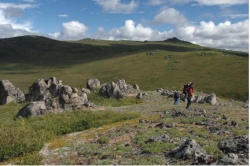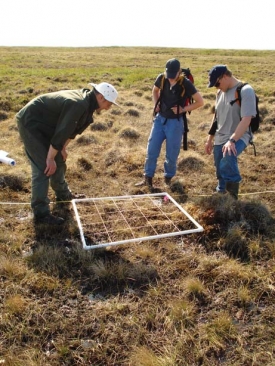The Ecosystem Science and Management Program (www.unbc.ca/esm/) houses 30 faculty with interests in all aspects of ecosystem function, from the cellular and molecular scale to the organismal and landscape scale, and the role of humans in modifying these ecosystems.
Paul Sanborn and master's student Lesley Dampier are working with the Yukon Geological Survey to explore the relationships between soil development and glacial history in the central Yukon Plateau, near Carmacks, a small community in Yukon Territory. The eastern edge of their study area was overridden several times by the Cordilleran Ice Sheet. The retreat of the last glaciation occurred approximately 12,000 years ago, leaving the area ice free. At higher elevations, though, the western part of the study area may not have been glaciated since the early Pleistocene. Since soil age is determined by the amount of weathering that has occurred, the complex glacial history has created land surfaces with considerably different ages. Dampier's research examines soil chemical and mineralogical properties across this range of ages to look for systematic differences. Initial field and lab results show that the oldest upland surfaces have retained very few of the original glacial deposits. Soils are formed primarily of sandy materials produced by disintegration of the local granitic bedrock, which has been weathered into striking tower-like masses, or tors, that dot the ridge crests (see image this page). Dampier's research is co-supervised by Quaternary geologist John Clague of Simon Fraser University.

Lesley Dampier, a UNBC master's student, takes in the alpine vistas of the central Yukon Plateau. The weathered granitic outcrops, called tors, on the ridge crests are typical of areas that have escaped two or more of the most recent glaciations by the Cordilleran Ice Sheet. Photo by Paul Sanborn.
Scott Green's research focuses on the response of plant ecosystems to future climate change. He recently completed a project examining arctic tree growth and distribution in relation to underlying climatic and environmental conditions to clarify some of the primary determinants and mechanisms of response. Preliminary findings from projects by graduate students Cheryl Johnston-Scheutz and Sean Sweeney suggest that continuous daylight during the arctic growing season is an important environmental factor in genetic selection of primary adaptive traits in trees (such as growth cessation during winter, allocation of above versus below ground tissues, and photosynthetic versus non-photosynthetic tissues). Continuous daylight may also induce high water stress in trees, which is an important limitation in tree regeneration in a changing climate.
The majority of Green's fieldwork was conducted along the northern Dempster Highway corridor in the Yukon and Northwest Territories. Project activities brought him into regular contact with communities along the highway, and these encounters have expanded his research interests. Environmental changes in the far north threaten the sustainability of small communities that have little adaptive capacity and minimal resources to respond to change. He sees an urgent need to forge partnerships between northern communities, universities, governments, and industries and work toward facilitating the adaptation and long-term sustainability of these communities.

Paul Grogan (at left), an ecologist from Queens University, collaborates with Darwyn Coxson on an IPY project called Climate Change Impacts on Canadian Arctic Tundra Ecosystems: Interdisciplinary and Multi-scale Assessments. In this picture, Grogan and students from UNBC and Queens University make plot based assessments of nitrogen fixing plants near Daring Lake. The site is located about 300 miles northeast of Yellowknife in the Northwest Territories. Photo by Darwyn Coxson.
To address this challenge, Green, along with Art Fredeen and Paul Sanborn, both of UNBC, and Hardy Griesbauer at the British Columbia Ministry of Forests, recently entered into collaboration with researchers from the Yukon Forest Management Branch. Their project is funded by Indian and Northern Affairs Canada and will examine forest vulnerabilities and adaptive capacities in Yukon Territory. One unique aspect of their research is that it will integrate community and management policy interests at the beginning of the project to direct research objectives and methodologies.
Keith Egger and Darwyn Coxson are part of an International Polar Year project called Climate Change Impacts on Canadian Arctic Tundra Ecosystems: Interdisciplinary and Multi-scale Assessments, which is funded by the Natural Sciences and Engineering Research Council of Canada (NSERC). The aim of the research is to provide the first comprehensive assessment of the state of tundra ecosystems in Canada. The overall project is large, involving 47 researchers, 18 post-doctoral fellows, 12 Ph.D. students, 23 M.Sc. students, 47 undergraduate students, and 48 students at all levels from northern communities.
The research is centered around the International Tundra Experiment (ITEX), a coordinated network of scientists and sites across the tundra biome established in 1990 to monitor long-term changes in terrestrial ecosystems and conduct warming and other environmental manipulations that test hypotheses related to effects of environmental variability and change on these ecosystems (see Witness Winter 2000/2001).
Egger and Coxson's research focuses on determining spatial and temporal variation in tundra soil processes that are important for carbon and nutrient transformation and production of trace gases. Tundra ecosystems are spatially patterned—in the high Arctic, typical patterns of vegetation and sediment created by frost action are known as sorted nets, while in the sub- to mid-Arctic, more evenly distributed frost-churned soils are found. Understanding how these spatial patterns control carbon and nutrient flux is critical to successfully modeling future changes in tundra ecosystems. Egger is focusing on the geospatial dependence of fungal diversity linked to carbon and nutrient flux, and Coxson is studying the geospatial dependencies in lichen communities relating to their ability to fix atmospheric nitrogen.
Kathy Lewis and her graduate student Nayeemul Karim are studying the historic and predicted future impact of fire-climate interactions on lichen succession in the winter range area of the Bathurst caribou herd. The herd, which calves near Bathurst Inlet in Nunavut and is harvested by hunters in the Northwest Territories, has continued to decline in recent years. Northwest Territories Environment and Natural Resources estimates that herd numbers have fallen from nearly 350,000 in 1996 to under 130,000 in 2006. Concerned groups, including management agencies, ecologists, and aboriginal people, have been struggling to understand the reasons for the decline and to find ways to sustain the population.
A decreasing availability of lichens during the winter months may be one reason for the caribou population decline, and fire disturbance is a key driver of lichen succession in the caribou's wintering ground. Lewis and Karim are in the process of reconstructing the past 300 years of fire history and climatic variability. This information will enable them to characterize the plant succession of winter habitats in relation to fire regime and climate change and the process of lichen supply for caribou. Greater understanding of caribou population dynamics and management implications for conservation, land use planning, and strategic fire management will be useful for resource managers, ecologists, and northern aboriginal people.
Chris Johnson, graduate students Leslie Witter and Tara Barrier, and collaborators with the Government of the Northwest Territories (GNWT) are also studying the Bathurst herd—specifically, summer and winter range ecology and mechanisms that may have contributed to the current population decline. Witter is investigating the influence of biting and parasitic insects on caribou behavior and movement, and Barrier is studying how habitat, fire history, snow, and predators influence the patch and landscape-scale selection strategies of caribou during winter. Their research is funded by NSERC, GNWT, and the Cumulative Impact Monitoring Program.
